
Donald Trump can’t let it go.
The presumptive Republican presidential nominee has faced days of pointed criticism for a Twitter attack on Hillary Clinton that used an image that looked like the Star of David and appeared to deploy anti-Semitic stereotypes.

When Laila Alawa woke up on a recent morning, her phone wouldn’t stop pinging with Twitter notifications.
“You’re not American, you’re a terrorist sympathizer immigrant that nobody in America wants and for good reason,” one user tweeted.
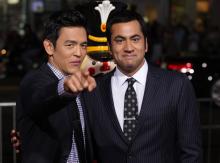
Hollywood, take notice.
The silver screen has been looking pretty white, and even those films that have more diverse casts haven’t been getting the recognition many think that they deserve, as #OscarsSoWhite can attest.

The pope of the digital age is set to attract even more followers with the posting of his first Instagram photo. Having already claimed the title of the world’s most influential leader on Twitter—with over 27 million followers across his nine accounts—Pope Francis has a new social media platform in his sights.

Every now and then Twitter just nails a hashtag, and defends the fundamental value of the Internet. This time, with #MemeHistory, people are pairing a contemporary “meme” with a famous event from history. Although the theme of #MemeHistory isn’t explicitly religious, many Twitter users couldn’t resist turning to the good book for inspiration.
All the greatest pieces of biblical drama are there: Jesus' resurrection, the Garden of Eden, Satan tempting of Jesus.
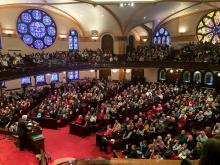
TRAVELING AROUND the country this winter has given me a tremendous opportunity to promote multiracial truth-telling in many local communities as well as to foster multiracial commitments to action in service of racial justice.
During the first two weeks of the “town hall” tour around my new book, America’s Original Sin: Racism, White Privilege, and the Bridge to a New America, we engaged an audience of tremendous diversity—multiracial, intergenerational, interfaith, secular, and intersectional. The audience and panelists at these forums have been baby boomers, Gen Xers, and millennials, and again and again we’re seeing new insights and directions as a wide variety of people and perspectives are brought into the dialogue.
In Baltimore, leaders who were in the streets with their congregants following the death of Freddie Gray, such as Revs. Heber Brown III and Brad Braxton, talked about the lessons they learned from the protests and how those lessons must be applied across the country in the days to come.
In New York, Heather McGhee, president of the public policy organization Demos, said that successfully navigating our country into the new demographic reality—in a way that removes both privilege and punishment based on skin color—could be the first opportunity to truly realize our “American exceptionalism.” I often speak against the notion of American exceptionalism, but I wholeheartedly agree with McGhee’s assessment.
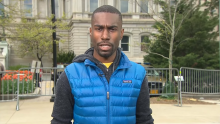
Minutes before the deadline to file for the Democratic primary in Baltimore on February 3, DeRay Mckesson completed the paperwork and entered the race.
With nearly 300,000 followers on Twitter, DeRay, as he's often known on Twitter, has gained widespread notoriety for his role organizing and documenting the Black Lives Matter movement. A former school administrator and Teach for America alum, DeRay first caught the public eye during protests in Ferguson and Baltimore. He is the 13th candidate to enter the Democratic primary in his hometown.
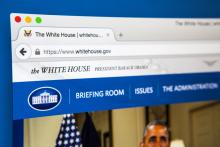
The meeting comes as nations around the world fight a sometimes losing battle against the highly-skilled online outreach of the Islamic State, which has done a remarkable job of using social media to create recruitment and public relations materials to promote its efforts. Apple, Facebook, and Twitter said Thursday they will have representatives at the meeting.
U.S. service members are using the hashtag #IWillProtectYou to show support for a young Muslim girl who believed her family would be forced to flee following Donald Trump’s call to ban Muslims from the country.
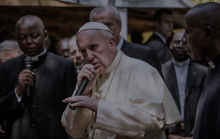
Anyone who’s ever read Pope Francis’ writings knows his flair for lyricism. Take the following passage from his “Laudato Si’”:
“Through our worship of God, we are invited to embrace the world on a different plane. Water, oil, fire, and colors are taken up in all their symbolic power and incorporated in our act of praise.”
This week, the Internet decided to help the Holy Father with his lyrics, just in case he ever decides to drop a rap album (and honestly, who knows with Pope Francis? He’s full of surprises. He did release a prog-rock album recently — truly.)
The inspiration for the Internet’s collective creativity was the below picture, in which Pope Francis looks like he’s about to spit holy fire.
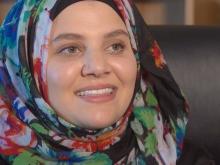
Fort Worth, Texas, native Amneh Jafari never expected to help spark an international movement.
But when the senior University of Texas Arlington psychology major saw a picture on the news showing Irving teen Ahmed Mohamed in handcuffs for bringing a homemade clock to MacArthur High School, it felt personal.
“It really saddened me,” Jafari said.
“I have younger siblings, and I felt like I was looking at them.”

Mormons teach, preach, and sing about families being together forever in heaven, but some members of the Utah-based faith want to exclude one group from that promise, at least on Earth.
Undocumented immigrants.
And, while the LDS Church supports immigration reform that keeps families together, its leaders have not pushed that idea in worship settings where Mormons are gathered. Nor has it called out those who disagree. In other words, The Church of Jesus Christ of Latter-day Saints has gone largely silent on the issue.
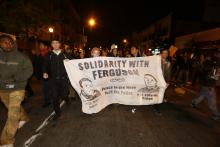
One year after the shooting and killing of Michael Brown, #FergusonTaughtMe is trending on Twitter. Activists, faith leaders, intellectuals, and everyday members of the movement have used the hashtag to explain how Ferguson fundamentally altered their racial consciousness. Embedded are a few tweets from Christian leaders who shared how Ferguson changed the way they do faith.
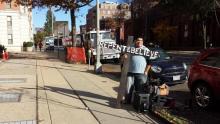
Some leaders use trending topics or hashtags to build momentum around a certain conversation. The idea is that by pointing followers to a catchy hashtag, activists can spark conversation and rally supporters around a cause. On Nov. 24, for example, Twitter lit up with the hashtag #PrayForFerguson after a grand jury decided not to indict a white police officer who fatally shot a black teenager.
One of the earlier noteworthy mobilizing campaigns included #KONY2012, a movement founded by a Christian, who launched a campaign to try to capture African Lord’s Resistance Army leader Joseph Kony. First Lady Michelle Obama famously participated in the #BringBackOurGirls campaign after more than 200 Nigerian schoolgirls were kidnapped by the terrorist group Boko Haram.
But everyone on Twitter is learning that a hashtag cuts both ways — it can be hijacked or lampooned by detractors, and it’s a key way that online activists are pushing back against opposing messages or what some might even call hate speech.

ISIS terrorist rampages, waves of anti-Muslim hate speech and fear-mongering Islamophobia are inspiring an outburst of online activism in the form of Twitter hashtags.
The question is: Does it work, especially over the long term?
An army of “clicktivists” — a mix of earnest advocates and pointed satirists — has entered the fray armed with 140-character positive, peaceful or humorous counter-messages.
Using names such as #TakeOnHate, #IStandUpBecause, and #NotInMyName, the pushback approach promotes the complexity, diversity and positive contributions of Islam and Muslims. Others, such as #MuslimApologies, offer sarcasm in service of the same message.
Yet the hashtags are often immediately co-opted by trolls spewing an opposite message. And some experts question whether clicktivist campaigns have lasting worth.
Linda Sarsour has no doubt they do. She’s a Brooklyn-based Palestinian activist in the streets and on social media and a co-creator of #TakeOnHate. The hashtag is accompanied by a resource website, launched in March by the National Network for Arab American Communities.
“The insidious thing about anti-Arab hate speech is that it seems to be acceptable, where the ‘N-word’ or anti-Semitic remarks are not taken with the same degree of outrage,” said Sarsour, who was chased down the street in September by a man who was later arrested for threatening to behead her.

God bless online media. Almost half of U.S. adults (46 percent) say they saw someone sharing “something about their faith” on the Internet in the last week.
And one in five (20 percent) say they were part of the Internet spiritual action on social networking sites and apps — sharing their beliefs on Facebook, asking for prayer on Twitter, mentioning in a post that they went to church.
“The sheer number of people who have seen faith discussed online is pretty striking,” said Greg Smith, associate director of religion research for Pew Research Center.
Megachurch pastors have mega-followings online. Joel Osteen of Lakewood Church streams his Houston services online. Rick Warren of Saddleback Church has 1.8 million likes on his Facebook page. And Pope Francis has more than 4.6 million English-language followers, chiefly American, for his @Pontifex Twitter feed.

What does a map of the U.S. religious landscape look like in 140 characters?
A new study of Twitter finds that self-identified religious users are more likely to tweet to members of their own faith than to members of a different one. The study examined people whose Twitter profiles identified them as Christian, Jewish, Muslim, Buddhist, Hindu and atheist.
And while adherents of all six groups studied tweet frequently, atheists — among the smallest populations in the U.S. — are the most prolific.
“On average, we can say the atheists have more friends, more followers, and they tweet more,” said Lu Chen, a doctoral candidate at the Kno.e.sis Center at Wright State University who co-authored the study with Adam Okulicz-Kozaryn of Rutgers University-Camden. They will present their findings in November at the sixth annual International Conference on Social Informatics.
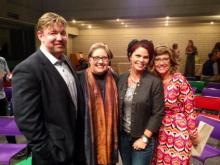
It was a gathering that would have been unthinkable just five years ago.
On a cool summer evening, in a borrowed classroom overlooking San Francisco Bay, about 150 men and women gathered to screen a short documentary about a Mormon family whose 13-year-old son came out as gay.
The Montgomerys, who accepted their son and his news, were ostracized by church members, some of whom refused to accept Communion distributed by the young man in church. Like many conservative Christian denominations, the 15 million-member Church of Jesus Christ of Latter-day Saints bans homosexual activity and considers it grounds for exclusion from Mormon rites, rituals and even the afterlife.

This week, the Baltimore Ravens terminated the contract of star runningback Ray Rice after video of Rice beating his then-fiancée Janay emerged online. Rice had previously been suspended for two games for the assault. With the release of the video, media scrutiny swiftly turned to his now-wife, speculating over why she would marry her abuser.
Beverly Gooden, a human resources manager and blogger, had a different response. Herself a survivor of domestic abuse, Gooden began tweeting of her own experiences, each one a vulnerable explanation: #WhyIStayed.
Gooden wrote, “I can't speak for Janay Rice, but I can speak for Beverly Gooden. Why did I stay? … Leaving was a process, not an event. And sometimes it takes awhile to navigate through the process. ...I hope those tweeting using #WhyIStayed find a voice, find love, find compassion, and find hope.”
We would all do well to listen. Some of the most powerful tweets below.